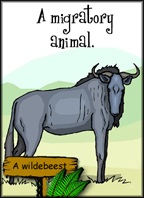Flashcards for teaching about animal behaviour


Home | Crosswords | Word Searches | Flash Cards | Verbs | Songs | Creative Writing | Work Sheets | Phonics | ABCs ESL Science | Potion Book | Spell Book | ESL for Adults | Ask Thomas | Lesson Plans | Holiday Worksheets | ESL Jobs
Quick Reference:
aquatic:
Animals that live in water or marine enivronments
domesticated:
Animals that live among humans.
endangered:
Animals that are in danger of becoming extinct because there are too few left from over hunting or loss of habitat.
extinct:
Animals that have disappeared from the earth.
hibernating:
Animals that sleep during the winter months.
migratory:
Animals that travel great distances at certain times of the year.
nocturnal:
Animals that are active at might. .
poisonous:
Animals that are toxic but have no means to deliver the toxin.
social:
Animals that live in groups, herds, pods, or packs.
solitary:
Animals that spend most of their time alone.
terrestrial:
Animals that live on land.
territorial:
Animals that defend a territory.
venomous:
Animals that have a poison AND a way to deliver it such as a bit or a stinger. Not the same as poisonous.
Nocturnal, Poisonous, Territorial, Aquatic, and Solitary Animals
Animal Behaviour Flashcards

Animal Behaviour Flashcards
At present, there are thirty-three animal cards and the eleven categories.
Make two copies of each card for a total of 66 cards. Students can play the game of fish to practice using the vocabulary.
There are two basic dialogues for playing fish. It doesn't really matter which dialogue you use.
Dialogue structure 1:
A: Is your animal nocturnal?
B: Yes, it is? (No, it isn't. Go fish.)
A: Is it a fruit bat?
B: Yes, it is. (No, it isn't. Go fish.)
Dialogue structure 2:
A: Do you have a solitary animal?
B: Yes, I do. (No, I don't. Go fish.)
A: Is it a cougar?
B: Yes, it is. (No, it isn't. Go fish.)
For ideas on how to use these cards visit the ESL Flashcards section, and to see more cards, check out the Flashcard Gallery.
These cards go well with the animal body parts cards which teach language such as tentacles, horns, antlers, hooves, and paws.
There are also several supplementary worksheets to go with these cards: